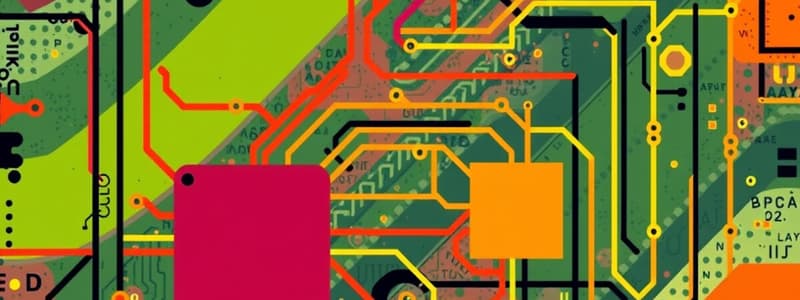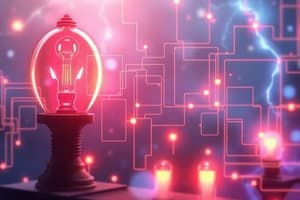Podcast
Questions and Answers
What happens when one component fails in a series circuit?
What happens when one component fails in a series circuit?
- The entire circuit is interrupted. (correct)
- The voltage will drop.
- Only that component stops working.
- The current will increase.
In a parallel circuit, if one component fails, the others can still function.
In a parallel circuit, if one component fails, the others can still function.
True (A)
What is the formula for Ohm's Law?
What is the formula for Ohm's Law?
V = I × R
The unit of power is measured in _____
The unit of power is measured in _____
Match the following components with their functions:
Match the following components with their functions:
Which of the following statements describes a characteristic of a parallel circuit?
Which of the following statements describes a characteristic of a parallel circuit?
A fuse is used to enhance current flow in a circuit.
A fuse is used to enhance current flow in a circuit.
What does a switch do in a circuit?
What does a switch do in a circuit?
Power is calculated using the formula: P = _____ × I
Power is calculated using the formula: P = _____ × I
Which component is responsible for providing energy in a circuit?
Which component is responsible for providing energy in a circuit?
Flashcards are hidden until you start studying
Study Notes
Electricity: Circuits
-
Definition of a Circuit
- A closed path through which electric current flows.
- Composed of various components such as resistors, capacitors, inductors, and power sources.
-
Types of Circuits
-
Series Circuits
- Components connected end-to-end.
- Same current flows through all components.
- Total resistance is the sum of individual resistances.
- If one component fails, the entire circuit is interrupted.
-
Parallel Circuits
- Components connected across the same voltage source.
- Different paths for current to flow.
- Total resistance is less than the smallest individual resistance.
- If one component fails, the others can still function.
-
-
Basic Components of Circuits
-
Resistor
- Limits current flow and drops voltage.
- Measured in ohms (Ω).
-
Capacitor
- Stores and releases electrical energy.
- Measured in farads (F).
-
Inductor
- Stores energy in a magnetic field when current flows through it.
- Measured in henrys (H).
-
Power Source
- Provides energy for the circuit (e.g., batteries, generators).
-
Switch
- Opens or closes the circuit, controlling the flow of current.
-
-
Ohm's Law
- Fundamental relationship in electric circuits: V = I × R
- V = Voltage (volts)
- I = Current (amperes)
- R = Resistance (ohms)
- Fundamental relationship in electric circuits: V = I × R
-
Power in Circuits
- Power (P) is the rate at which electrical energy is transferred or consumed.
- Calculated using the formula: P = V × I
- Measured in watts (W).
-
Circuit Diagrams
- Visual representation of a circuit using symbols.
- Helps in understanding and analyzing circuits.
-
Safety in Circuits
- Importance of fuses and circuit breakers to prevent overloads.
- Insulation of wires to prevent short circuits and electric shocks.
-
Applications of Circuits
- Used in household appliances, electronic devices, telecommunications, and power distribution systems.
Definition of a Circuit
- A circuit is a closed path allowing electric current to flow.
- Composed of components like resistors, capacitors, inductors, and power sources.
Types of Circuits
Series Circuits
- Components are connected end-to-end, forming a single path for current.
- The same current flows through all components.
- Total resistance equals the sum of individual resistances.
- Failure of one component interrupts the entire circuit.
Parallel Circuits
- Components connect across the same voltage source, creating multiple paths for current.
- Total resistance is lower than the lowest individual resistance.
- If one component fails, the remaining components can continue functioning.
Basic Components of Circuits
- Resistor: Limits current flow and reduces voltage, measured in ohms (Ω).
- Capacitor: Stores and releases electrical energy, measured in farads (F).
- Inductor: Stores energy in a magnetic field when current flows, measured in henrys (H).
- Power Source: Supplies energy to the circuit (examples include batteries and generators).
- Switch: Opens or closes the circuit, controlling current flow.
Ohm's Law
- Describes the relationship between voltage, current, and resistance: V = I × R.
- V denotes voltage in volts.
- I represents current in amperes.
- R indicates resistance in ohms.
Power in Circuits
- Power (P) measures the rate at which electrical energy is consumed or transferred.
- Calculated by the formula: P = V × I and measured in watts (W).
Circuit Diagrams
- Provide a visual representation of circuits using symbols.
- Aid in understanding and analyzing circuit functions.
Safety in Circuits
- Fuses and circuit breakers are crucial for preventing overloads.
- Proper insulation of wires is essential to avoid short circuits and electric shocks.
Applications of Circuits
- Utilized in household appliances, electronic devices, telecommunications, and power distribution systems.
Studying That Suits You
Use AI to generate personalized quizzes and flashcards to suit your learning preferences.




